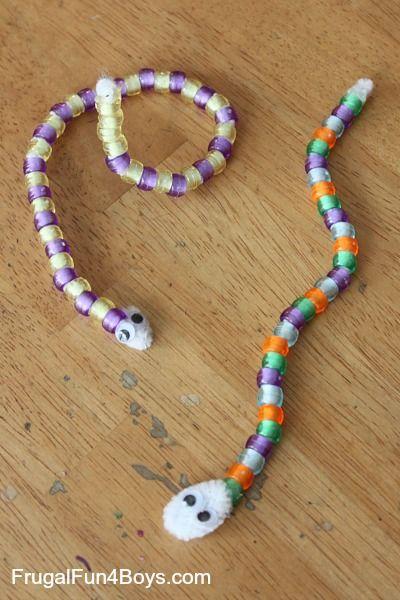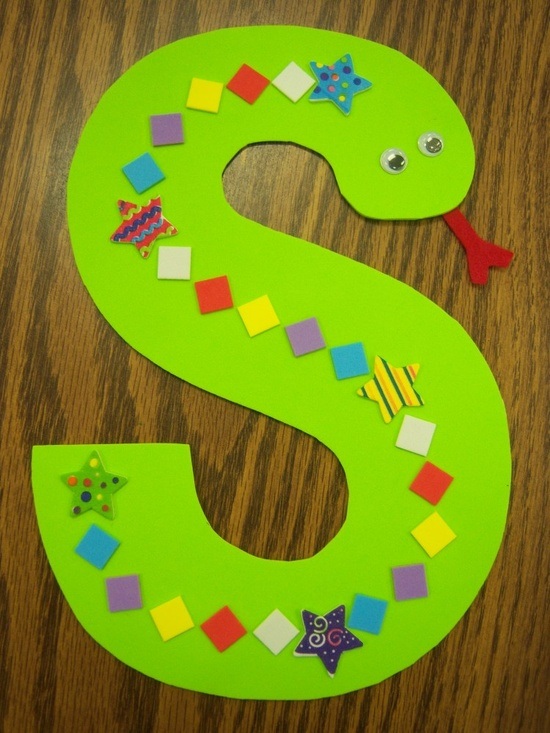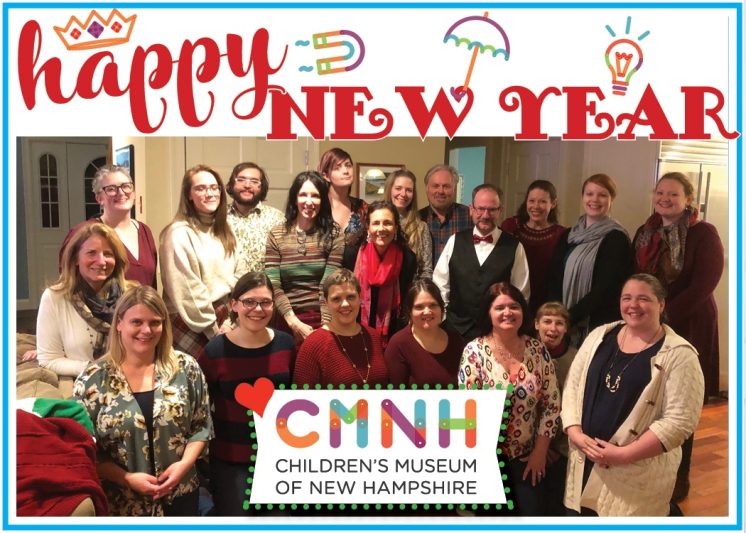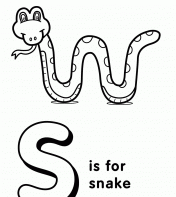GAME: Pattern Snake Hide and Seek


By Colie Haahr, CMNH Educator
This is an active game, but can be done with no running, indoors or outdoors!
Kids love hiding things and finding things, so this is a game that can last for quite a long time, and can be played with just two people or more.
Set up: First, have each player create a snake. You can use pipe cleaners and beads to make a pattern snake. If you do not have materials available to make a pipe cleaner snake, you can color a snake instead by drawing a snake, having your child draw a snake, or using a template.
Game play: Once everyone has decorated or put together a snake, take turns hiding and finding them. There are a few different ways to do this. If younger kids are playing with older kids, a variation that works well is to have a grown up hide all of the snakes, and kids can search for and find only their own snake. This makes the game more fair in that one person will not find all of the snakes right away.
Rules:
- Use your own house rules for hide and seek: this usually includes no peeking while someone is hiding or hiding items!
Explore more:
Add to the fun: have a “pattern pageant” with a grown up as the judge. Inspect the patterns, ask kids to come up with hidden talents for their snakes, and choose a snake as the winner. Maybe it’s the snake that would blend in best in the natural world, the one with the best pattern, or the child who didn’t do so well in the hide and seek game ;)
Talk about why animals have patterns in nature. Usually, this is to send a message to other creatures, such as “I’m dangerous!,” or to help the animal blend in to stay safe from predators. Some animals have patterns that mimic other things, allowing the animal to appear larger than it really is, or blend in with a different group of animals. Elementary aged kids could do some independent research to see who can find the animal with the best camouflage!
Try this printable paper chain python activity:
If you do not have a printer you can make a paper chain by simply cutting up strips of construction paper or copy paper.
Try this printable spiral snake:
Kids can color it in, but may need help from a grown up to cut it out. These would be neat to hang from the ceiling once completed!
This is a very similar activity, but involves finger painting the snake to create a pattern:
You could also make a pattern like this using the CMNH Wacky Art bubble wrap painting method.
Two Ingredient Snow Dough
By Colie Hahr, CMNH Educator
Our most popular drop-in STEAM activities at CMNH seem to involve making messy mixtures! From slime, to dough, to puffy paint most kids love getting their hands a little dirty, and enjoying a sensory experience while they play and create.
One of the easiest make-at-home messy projects is two ingredient snow dough. It’s part science experiment and part sensory play, and honestly just a bit messy compared to the wild world of slime!
Materials:
- Table cover of some kind (a trash bag works!)
- Corn Starch
- Hair conditioner -white works well
- Mixing bowl
- Measuring cups
- Mixing spoon
- Optional: food coloring, cookie cutters, placemat or tray for play, playdough accessories
Dough recipe: this dough has a one to two ratio of liquid to solid ingredients, so it is easy to double or halve the recipe:
Ingredients:
2 cups cornstarch
1 cup inexpensive hair conditioner
Food coloring (optional)
Directions:
- Add the food coloring (optional) to the conditioner, then mix in a large bowl.
- Add the cornstarch to the bowl and mix thoroughly. Kids can take turns mixing. Keep mixing with a spoon until the consistency seems like playdough
- If the mixture is too wet, add corn starch, and too dry add a little more conditioner. Avoid handling the dough until it looks nice and smooth- this will help contain the mess in the bowl until it is ready to be handled.
- Play with the dough using cookie cutters, stamps, small figurines, or other manipulatives of your choice. It is washable from most surfaces, but kids should be supervised as they would with playdough
What Happened? Once the dough is mixed together, a whole new material has been created, however, the reaction is complicated because the conditioner includes several mixtures and solutions in its ingredients. A mixture is when two substances are mixed together, but you can separate them back into their individual parts. Trail mix is a good example of a mixture. A solution is a substance where you mix ingredients together, and it’s not possible to separate them. Hot Cocoa is an example kids may understand: once you mix hot cocoa powder with milk or water, can you turn it back into milk or water again?
For this activity, you mixed together two different ingredients to make something new. The corn starch is a solid, even though it is a very fine powder. It’s similar to the shape, size, and texture of sand, so making this comparison may be helpful for kids to understand that something can be solid, but also be made of very small parts. Corn starch is used to help make things thicker for cooking, and it also helped to make the dough thicker and more solid.
The other ingredient is hair conditioner, which is a liquid even though it is very thick. The conditioner helped to make the dough softer and easier to mold. The dough you created is still a solid, but it is able to be sculpted and shaped! The ratio of conditioner to corn starch is what made the dough work. This recipe used a 2 to 1 ratio, so there was twice as much cornstarch as conditioner. Older kids can work on fractions, adding, measuring, and dividing as part of this project.
One way to explain this experiment to kids is to ask them to think about making a cake. When you mix all of the ingredients together to make a cake, the ingredients go through a physical change and create a mixture. When the cake goes into the oven to bake, a chemical change takes place, and the batter mixture turns from liquid into a solid baked cake. It would not be possible to take the eggs, flour, or milk back out of the cake once it is cooked, and that’s part of what makes it a chemical change rather than a physical change. For matter to change, usually something needs to be added such as heat or pressure. We didn’t add heat or pressure for this experiment, so even though the dough was very different from the two ingredients that we put together to make it, it is still a physical change. We did not cook it like a cake, AND it’s not edible, so don’t eat it!
Physical Change: A physical change is a type of change in which the form of matter is altered but one substance is not transformed into another. For example, folding paper to make an origami crane changes the shape and size of the paper, but it is still paper.
Chemical Change: A chemical change is any change that causes a new substance to be formed. For example, if an origami crane were to catch fire and burn, the paper would turn into ashes, a new substance.
Mixture: A substance made by mixing other substances together. For example, trail mix.
Storage: The dough should last for about a month if it’s sealed up in a container. Add a little water to the dough if it dries out, and it will last longer.
Tinker Time at Home!
by Meredith Brustlin, CMNH Educator
Every week at the Children's Museum of New Hampshire we host a program called “Tinker Time”. Tinker Time is a drop-in program that emphasizes the importance of tinkering! Tinkering helps children develop fine motor skills, increase problem-solving abilities, and is an open invitation to foster peer relationships.
What I love about tinkering is that it’s open-ended and no-fail. The carefully selected activities are designed to have many possible solutions and ways to explore. This means that children with different learning styles, who are different ages, and have different interests can all get something out of these activities.
I usually set up the tinkering program with five different activity areas: Art Material Creations, Sorting, Building, Sensory/Texture Play, and Cause & Effect Exploration. I’m sharing one activity from each of these categories, but please don’t feel like you have to set-up all of them to have a successful tinker time! Set up one or two - use these activities as jumping off points and then tweak it to match the supplies you have at home or your own child’s interests - it’s totally up to you!
Enjoy tinkering!
Art Exploration: Sticker drawing prompts
- Place round tickers (or draw round circles with different colors) on index cards or pieces of paper. Invite your child to use the placement of the dots to make a picture!
- Try putting the same configuration of dots on several pieces of paper and have a “draw-off” with the whole family - see how different your drawings are even though you were given the same prompt!
Sorting: Color sorting
- Gather lots of different art materials from around your house (markers, permanent markers, crayons, hi-lighters, colored pencils) and invite your child to sort them.
- Will they sort them by color? By type of art material? By size?
- Invite children to try and make a pattern using the colorful art materials!
Building: Cup towers w/ manipulatives
- Collect plastic cups from around your house
- Find some small manipulatives - little animal or people toys.
- Build homes for the animals or build fences around them. Hide little people in the cups and guess where they are.
- See who can make the tallest tower!
- Build a tall tower and then throw a ball at it to knock it down!
Sensory/Textures: Cars on Salt
- Sprinkle salt all over a cookie sheet or other container
- Use toy cars, toy animals, or just hands to explore the salt and make designs!
Cause & Effect: Is it magnetic?
- Collect small items that are either magnetic..or not magnetic...and place them in a container
- Find a magnet on your fridge that is powerful enough to pick up some small items
- For younger children: test and see which of the items are magnetic! How many items were you able to pick up using the magnet?
- For older children: invite them to pre-sort the items into piles of items they think will be magnetic and ones that they do not think will be magnetic. Use the magnet to test their predictions!
St. Patrick’s Day Treasure Hunt!
Materials Needed:
- Cake pan or other container with deep-ish sides
- Baking Soda
- Vinegar or lemon juice
- Green food coloring
- Spray bottle or small bowl
- If using a bowl, also have a spoon
- Coins/spare change
Prep the activity:
- Place a trash bag or plastic tablecloth over the “experiment area” (food coloring can stain!)
- Spread out the coins on the bottom of your cake pan
- Cover the coins with baking soda
- Fill the spray bottle or small dish with vinegar/lemon juice and green food coloring
Invitation to play:
- Welcome your little one(s) into the science area and explain that some leprechauns stopped by and left a science experiment...and some treasure!
- Invite them to begin investigating---spraying the spray bottle or carefully spooning some vinegar onto the baking soda
- Inquire: What is happening? What do you notice? What do you hear? Why is that happening? What is hiding under the baking soda?!
The science:
- Vinegar is an acid and baking soda is a base. When acids & bases are added together--we get a chemical reaction! A chemical reaction is when you combine two substances and create something new. In this case, we are combining vinegar (a liquid) with baking soda (a solid) and getting a gas (carbon dioxide!) We can HEAR the carbon dioxide being created when we listen for the fizzing/bubbling sound.
Happy St. Patrick’s Day!
Closing Through March
In the interest of doing our part to support the health and wellness of our community and each other, the Children’s Museum of New Hampshire will temporarily close to the public beginning at 5 pm, March 14th, 2020, through the end of March. All efforts will be made to reschedule cancelled events, and all groups and individuals affected will be contacted by our staff.
Over the coming weeks, our staff will continue to work both off-site and on-site with appropriate social distancing procedures. We will take this time to deep clean and refresh our facility & exhibits, plan programs and events, and host virtual online activities with our educators to engage children and families during this challenging time.
We will continue to monitor developments and share any updates via our website and social media channels. We appreciate your support and understanding and look forward to welcoming you back to the Museum when we reopen!
Staying Healthy at CMNH
At the Children’s Museum of New Hampshire, the well-being of children and families is always our first priority. We take great care to ensure the cleanliness of our space and train our staff on the practices and procedures that lead to healthy and happy communities— every day.
In light of concerns related to the recent coronavirus (COVID-19), we want to take this opportunity to address the health and safety measures we are taking to protect the health of our visitors, both big and small.
1. We are committed to following public policy. CMNH adheres to the safety procedures and protocols recommended by the Centers for Disease Control and Prevention (CDC), the Association of Children's Museums, and the NH Department of Health and Human Services (NH DHHS).
2. We invest in cleanliness. The Museum has best practice standards and processes in place for the cleaning, sanitizing and disinfection of the Museum, including exhibit areas and common areas, as well as “loose” interactive items (costumes, props and other consumables). These standards include:
- The Museum team cleans and disinfects both common and exhibit areas (affixed and loose parts) throughout the day.
- The Museum undergoes a deep and thorough cleaning after hours every day by third-party custodial staff, including common areas (bathrooms, hand rails, door handles, elevator buttons, floors etc.).
- All cloth props (costumes, puppets, etc.) are machine washed daily using a high temperature cycle.
- Containers for toys placed in the mouth are located throughout the Museum and are cleaned with professional disinfectant before they are returned to the Museum floor for use.
3. We promote personal steps to reduce the spread of germs. We know that washing your hands regularly and properly is one of the best ways to prevent the spread of germs or flu. We promote hand-washing with our visitors and staff and have 16 sinks with soap and paper towels in common areas and bathrooms, and we provide 13 alcohol-based hand sanitizer stations throughout the Museum. We remind all staff and visitors that the best way to prevent the spread of germs is to stay home if they are feeling unwell.
We are committed to the safety and wellness of our museum community and will keep you informed, as necessary, regarding this evolving situation. We will continue to follow the guidance and recommendations of the CDC and NH DHHS and be in touch if any of these recommendations impact our programs and schedule.
Sincerely,
Jane Bard, President
and the entire team at the Children’s Museum of New Hampshire
Sick Visitor Policy
SICK VISITOR POLICY
The Children's Museum of New Hampshire works to provide a safe and healthy environment for all of our visitors. Towards this end, we request the following policy be followed by our visitors, staff and volunteers.
A general rule to follow is that if you or your child have a fever or are too sick to go to work or school, then you are too sick to visit the museum.
The following guidelines are more specific and we request that visitors with these symptoms not visit the museum:
- Flu (headache, fever/chills, lethargy, cough)
- Conjunctivitis or “pink eye” infection
- Diarrhea or vomiting
- Impetigo (infectious skin disease which shows up as small pimples that turn into red blisters in a circular pattern)
- Lice
- Strep Throat (child must be on antibiotics for 48 hours before coming to the museum.)
- Any of the following contagious diseases: measles, mumps, rubella, roseola, and chicken pox. Children with chicken pox may not come until all of the sores are crusted and there are no new eruptions.
Museum staff carefully monitors our Museum facility around the clock. We clean each exhibit on a rotating schedule, have after-hours staff cleaning daily, encourage parents to identify items that may need to be cleaned, and have 14 hand sanitizer stations throughout the museum.
2019: A Year In Review!
As 2019 draws to a close, it’s a great time to reflect on the growth and change the Museum has experienced over the past year, and look ahead with anticipation to what 2020 will bring. Even after 36 years of creating experiences to engage children in hands-on fun and learning, each year still brings new challenges and opportunities.
In the past twelve months we:
- piloted three new fundraising events – Cider Flights & Tasty Bites, UnWined Grown-Up Night and Mini Golf at the Museum. All three events will continue in 2020 thanks to their success!
- hosted our final 5K Road Race. Thanks to all the runners, sponsors and the Seacoast Road Race Series for supporting this event throughout the past 34 Years.
- transformed an existing classroom into the Lights! Shadow! Action! Interactive Classroom that now serves as an engaging exhibit with the flip of a switch.
- converted our lighting to LEDs, continuing our commitment to being earth-friendly and cost effective.
- raised nearly $200,000 for a new outdoor space, the Play Patio, slated to open in the summer of 2020!
- increased our operating hours by opening at 9am to better serve our visitors.
- served a record number of visitors and program participants – over 110,000, an 8% increase over the previous year.
- launched a new three-year strategic plan that focuses on providing outstanding guest experiences, engaging in best business practices, expanding marketing efforts and growing our audience in purposeful ways.
All of us at CMNH are lucky to be surrounded by families and caregivers who want the best for their children, helpful volunteers and generous donors who want to make a positive impact in children’s lives, passionate educators who strive to spark a love of learning in their students, and vibrant communities that welcome us with open arms.
Thank you for being part of our story and success!
Sincerely,
Jane Bard, CMNH President


